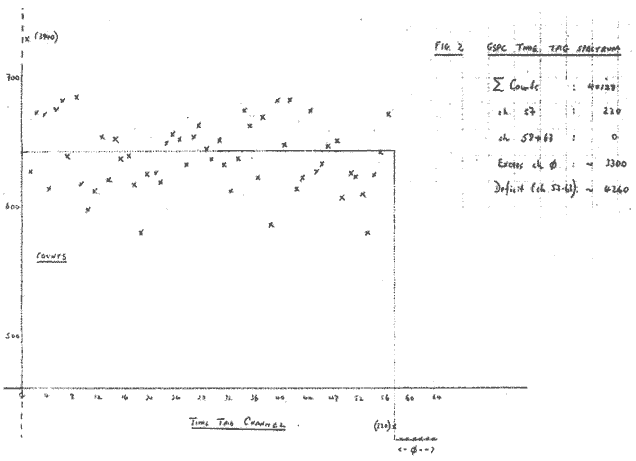GSPC DEAD TIME CONSIDERATIONSThis note extends to the GSPC experiment the discussion of experiment dead times given in Express No. 10, p.35 for the ME. Reference is made to the hardware status report (p.2) on the partially functioning upper level single channel analyser (SCA) energy discriminator. Because there is no sharp upper cut-off by the SCA (E) at channel 240 of the ADC spectrum, the valid-events counter (QEP) integrates according to the detector response all counts between channel 240 and 255 (maximum. ADC channel) and above channel 255 as illustrated in Fig.1. Note, that the ADC inherently has a sharp cut-off at channel 255 and that there is therefore no simple correlation possible between spectral counts and QEP. All calculations of fluxes should therefore, as a baseline, integrate the spectral counts (ADC) between given channels (eg. ch.30 to ch.240 ie. 2 to 16 keV at gain 2) and include the necessary corrections for dead time effects. Figure 2 shows the distribution of time tags (raw channel counts) of a sample of GSPC events (40128, mainly background), selected on board according to valid E with a sample scheme of E, BL, TT at 2k s-1 and the BL acceptance window set to nominal. Note that the maximum time tag possible is 63, determined by sample interval/clock period (488.2 µs/7.63 µs) and that the following contribute to the overall dead time: a. Loss of events from an expected flat random input signal because of the restriction of Simple Poisson statistics give the dead time correction factor associated with (a). A fixed correction (~2.5%) must be included to account for the overall loss of events from time tag channels 57-63 representing the time between the sample pulse trailing edge and reset ( 2 x 7.63 µs TM clock pulses). For a 2k s-1 sample rate, 15.26 µs/483.1 µs gives approximately 3% in fair agreement with the observed loss. In principle a second order correction should be applied, as for the ME, for the probability of events occurring in channels 57-63 having a second event within the period of the next sample cycle (which is effectively "dead" in these cases) but for normal GSPC count rates this correction can usually be neglected.
Note that approximately 6.66 time tag channels have zero data
corresponding to a reset occurring within the time of ADC conversion
and time-to-amplitude burst length conversion (in total 48 µs) in
comparison with the ME (4.5 channels - ADC conversion only).
Fig. 1 Typical GSPC Energy Spectra Fig. 2 GSPC Time Tag Spectrum |


 1 event/sample
interval, statistically
insignificant in figure 2 because of high samplerate 2Ks-1)
and low event rate (background ~30 s-1).
1 event/sample
interval, statistically
insignificant in figure 2 because of high samplerate 2Ks-1)
and low event rate (background ~30 s-1).
